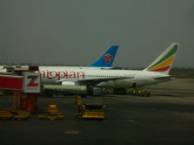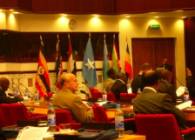|
REPORT FROM THE OFFICE OF THE ADVISOR LIAISON AND PROMOTIONS PERSON, A RAY OF HOPE, UNESCO YOUTH AMBASSADOR FOR THE CULTURE OF PEACE.
With many deep and stupendous gorges, crowned by high and magnificent mountains, neck laced by a chain of lakes, watered by majestic rivers, studded with burning deserts and great escarpments that plunge down from its highlands, Ethiopia is a land of wonders and enchantment. It is beyond imagination. More than three million years ago, one of Ethiopians first ancestors walked that portion of earth that is now Ethiopia: namely, Lucy (Dinkenesh to Ethiopians), meaning ‘Thou art wonderful’. Its ancient and medieval monuments, its proud and colourful cultures, and its varied and often unique wildlife sets it apart from all else. Ethiopia, dissected through its middle by the scar of the Great Rift Valley, is as old as time itself. It is the land claiming a history that goes back to the Old Testament. It is the land of Sheba. Many visitors know Ethiopia for its splendid rock-hewn churches and colourful ceremonies. But it is Ethiopians who join with the spectacular scenery, abundant fauna and fascinating religions to truly round out the character of this ancient land.
I have been in Addis Ababa since the 12th of February, 2008. Addis Ababa, a big, hospitable and sprawling city was founded in 1887 by Emperor Menelik and still bears the stamp of his exuberant personality. By late 1950s Addis Ababa was recognized as the unofficial capital of Africa and thus was made the headquarters of the United Economic Commission for Africa (ECA) in 1958. Later in 1963, it was chosen as the headquarters of the Organization of African Unity (OAU). Located at the centre of Ethiopia, the city stands at the very heart of Ethiopia and enjoys connections with the country’s economic zones. Addis Ababa is Africa’s unchallenged diplomatic capital, with more than 70 Embassies and consular representatives clustered into the mountain city. NOVATECH CONFERENCE 2008: The ICT Africa
Marketplace. The
Novatech conference took place from 13th to 15th of
February, 2008 at the United Nations
The purpose of this event was to facilitate business contacts and to stimulate investment and cooperation agreements in the East Africa and Indian Ocean Region by bringing together African, European and Third countries players and decision makers active in the Information and Communication Technologies ((ICT) sector. One key factor of the event was the one-to-one business meetings between participating companies, institutions and A Ray of Hope. These meetings enabled participants to discuss in a timely and effective manner of business opportunity and Synergies for Africa’s development in ICT. The
NOVATECH 2008 –ICT market place in Addis Ababa, Ethiopia, is
a component of the ProInvest programme which is a common initiative of the European Commission (EC) and
institutions from the ACP states (Africa, the
Caribbean and the Pacific). ISSUES DELIBERATED UPON: These
among others were crucial topics deliberated on at the conference. ·
Volunteer
Computing by
Amoako Gordon Nana Kwesi and Peter Amoako-Yirenkyi:
This is a technology that takes advantage of a
PC’s idle time to do meaningful simulations. It takes the advantage of
your otherwise unused CPU cycles in an effort to do
things like predict global climate change, calibrate particle accelerators, or
develop drugs to combat cancer and AIDS or malaria. Sometimes it is termed
public resource computing. In volunteer computing, heavy public
participation is always available for simulations to be completed. There
is an increasingly growth factor in internet usage worldwide and that is
in favour of volunteer computing. The power of this technology could
therefore be harnessed to solve scientific problems on the African
Continent. The onus lies on the African scientist to make good use of a
simple but yet powerful technology in solving useful problems and Africa
would see an overwhelming improvement in the control of malaria and other
deadly diseases. And most importantly Africa can rely on the world's
internet community to solve problems once they are able to think through
scientifically. ·
Why
Fibre Optics on Modern Networks: by
Dr. Jabulani Dhliwayo: Several
developments in the telecommunication environment in South Africa and the
surrounding region are expected to boost the development of Information
and Communication Technology (ICT) Infrastructure, boost bandwidth usage
and improve access networks to the end users. The liberalization of the
Industry includes the licensing of a second network operator, Neotel, and
the imminent conversion of some Value Added Network Services licenses
(VANS) to Electronic Communication Network Services (ECNS) licenses. ECNS
licensees are expected to “self provision” or deploy their own
telecommunication infrastructure,
thereby providing the much anticipated competition against the incumbent
Telecommunication companies. Any access networks that will by-pass
Telkom’s network will result in price pressure on Telkom’s ADSL
(Asymmetric Digital Subscriber Lines) services which are currently the
most expensive in the world. In the next couple of years, more South
African premises are expected to have access to less expensive broadband
services, including data and Voice over Internet Protocol (VoIP).
Furthermore, several planned undersea projects such as the East Africa
Submarine System (EASSy) and The East Africa Marine Systems (TEAMS) will
provide competition to SAT-3 and result in lower cost of International
bandwidth which is currently among the highest and beyond the reach of
most service providers. For those considering deploying or upgrading
premises networks such as in office parks, multi-dwelling units and gated
communities it is imperative to deploy technologies today that will be
commensurate with tomorrow’s bandwidth requirements. Optical
telecommunication has proved to be the most future proof technology for
increasing bandwidth demands. It has been demonstrated in more developed
parts of the world, that the ever increasing bandwidth requirements have
driven significant increases in the cost of copper network systems, while
technological maturity has led to relative declines in the cost of optical
systems. In light of these changes, optical networks are becoming the most
suitable technologies for growing bandwidth requirements. Tomorrow,
increasingly higher performance from the premises network will be
demanded, but at the same time simple installation, reduced installation
costs, and a long network lifecycle will be required. This article will
explore the performance and cost advantages of optical fibre relative to
copper in relation to modern premises network applications. It
is widely accepted that optical fibre premises networks offer much greater
bandwidth and reach capabilities over UTP copper alternatives. In this
paper we have illustrated that the enhanced performance capabilities of
optical fibre lead to network cost savings in terms of reduced
installation and operating costs. As the relentlessly rising bandwidth
demands of the Ethernet revolution continue, the installation and
maintenance costs of UTP cabling have increased significantly, such that
it has become more cost effective to deploy optical rather than copper
networks in high data rate premises systems. ·
Information
and Communication Technologies and Economonic Empowerment in Nigeria by S.U.Fwatshak and Temmylade Aladeokin: This
piece provides a framework for the use of Information and Communication
Technology (ICT) as an
agent of economic growth and development in Nigeria by examining past
achievements, current challenges, and future possibilities in the Internet
and mobile phone industries. Although sub-Saharan Africa lags behind other
parts of the world in the area of ICT, Nigeria has demonstrated a record
of growth in this domain. A number of issues still need to be addressed
including low penetration of ICT, inadequate ICT skills, poverty, and
electrical power problems. Despite these challenges, ICT has contributed
to Nigeria’s economy in several important ways: new jobs have been
created, the revenue base has expanded, industrial growth has improved,
and ICT skills have been developed. There is a need to tackle poverty, which is pervasive in Nigeria. There are, however, different opinions on the best strategy to adopt in this direction. Some people believe that industrialization holds the key. And there is a growing opinion that widespread use of ICT contributes to economic growth and development and has the potential to economically empower people. Both views appear valid and are, complementary in the following respects. On one hand, the main products sold in the international market and through e-commerce are industrial goods. On the other hand, ICT is responsible for the success of most business transactions in an era of globalization. These suggest that the multivariate approach to development needs to be given better consideration by policy makers. The success of countries that have adopted ICT worldwide also suggests that the present and perhaps the future of the global economy depend on it. As Nigeria strives to achieve economic growth and development, and ultimately, the economic empowerment of its citizens, the digital economy shaped by the ICT economy, offers a new frontier for exploration. ICT provides a vital supplement (or even an alternative) to the material-based economy, whose fortunes and contributions to national economic growth and development have been shrinking. Adoption of ICT is consistent with national policy aimed at diversification of the economy. ICT is a very important driving force in economic growth and
development and therefore, an agent of economic empowerment. This paper
has shown some of the contributions of ICT in the economic growth
and development as well as empowerment of Nigeria by
examining past achievements, current challenges,
and future possibilities. ICT’s growth profile was described and
analyzed to show that although sub- Saharan Africa lags behind other parts
of the world in the area of ICT, Nigeria has a demonstrated record of
growth in this domain. There are now scores of Internet
Service Providers, a few indigenous computer manufacturing companies. In
the year 2001,
mobile
phones were officially introduced to Nigeria and today
there are four major GSM operators apart from several other PTOs.
The introduction of GSM mobile services has increased the teledensity of
the nation from less than 0.5 to 0.8 in six months,
making Nigeria one of the
fastest growing telecommunication markets in Africa. The number of GSM
subscribers is more than two million. Fixed lines were estimated to be
702,000 in 2002, as Fixed Wireless Access operators are increasing in
numbers. Other ICT facilities include Radio, and television, as well as
satellite communications. In spite of the growth profile, there are still
many challenges/problems that need to be tackled. Among the challenges
faced by the ICT sector are low penetration, poor and inadequate
infrastructure, illiteracy, poverty, high cost of access. Nigeria is the
most populated country in Africa, but her ICT status is behind those of
many countries on the continent. Literacy levels are also low as power
problems are serious among others. We included some suggestions for
tackling these problems including the liberalization of the power sector,
and the building of ICT environment friendliness through reduction of
telecommunication taxes, and government initial investment in the ICT
where the private sector is weak. ICT has made and is making contributions to economic growth and
empowerment in Nigeria. It provides employment to thousands of people
directly and indirectly. It improves the revenue status of the country by
contributing billions of Naira in license fees, taxes, and import duties.
ICT is also contributing in the area of skills development through various
training programs offered by private and public institutions. As
Governments, organizations, institutions, businesses, industry are
increasingly dependent on ICT for their efficiency and competitiveness,
ICT holds high promises for the future economic. COURTESY
VISIT TO ORGANISATIONS: TENA
KEBENA AND GINFILE CLEANED ASSOCIATION (TKGCA). The Tena Kebena and Ginfile Cleaned Association was initially
conceived and established by Akalu and Desalengne Firew in 1993 Ethiopian
Calendar. Te association was established by a total number of 10 members
and was involved in various activities related to its mission and
objectives which are listed below. The major principles of this
association are to involve all sectors of the society regardless of age,
sex, culture and political beliefs in Environmental sustainability of
Ethiopia’s Natural reserves and to form a healthy working relationship
with individuals, offices and authorities concerned. The
main objectives are: ·
To expand urban farming using the rivers as well as to develop and
protect local areas. ·
To put into effect the mechanisms for preventing and controlling
the spread of HIV /AIDS; to give basic training that will improve the
consciousness of the public about the deadly disease. ·
To protect the rivers from pollution. ·
To work toward the alleviation and prevention of poverty, hunger
and unemployment. ·
To actively participate in all social and development-oriented
activities going on in the country. ·
To create awareness of the society on environmental issues. Major Achievements so far: ·
The Green Award winner 2006 and 2007 ·
Establishment of environmental music band ·
Organized tree planting in different parts of Ethiopia to replace
destroyed forestation. ·
Built Green house to cultivate natural flowers and vegetables. ·
Provided care and support to the people living with HIV /AIDS (PLWHA)
and orphans from the income received from different individuals and
organizations.
|



